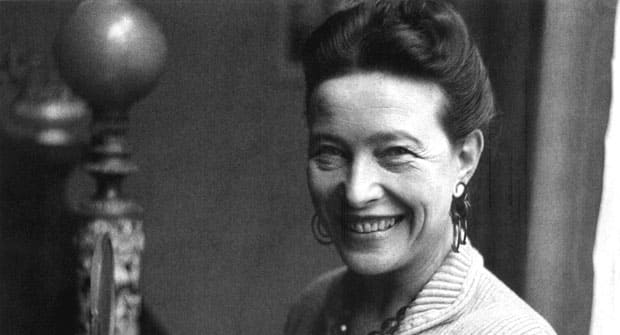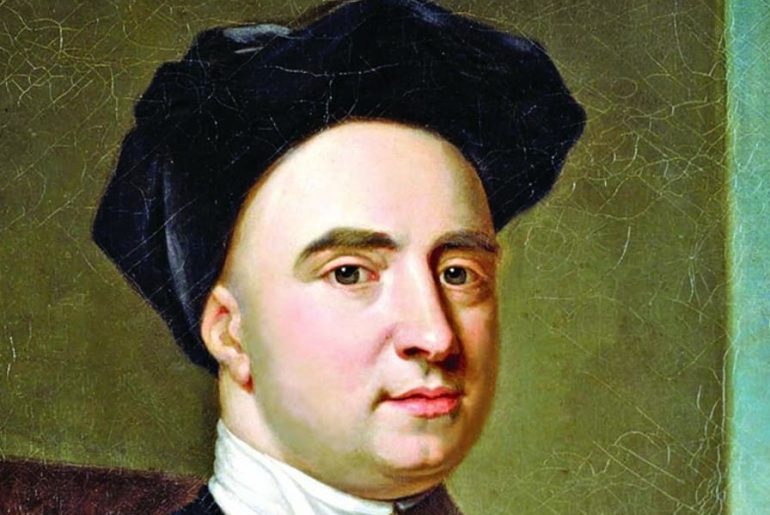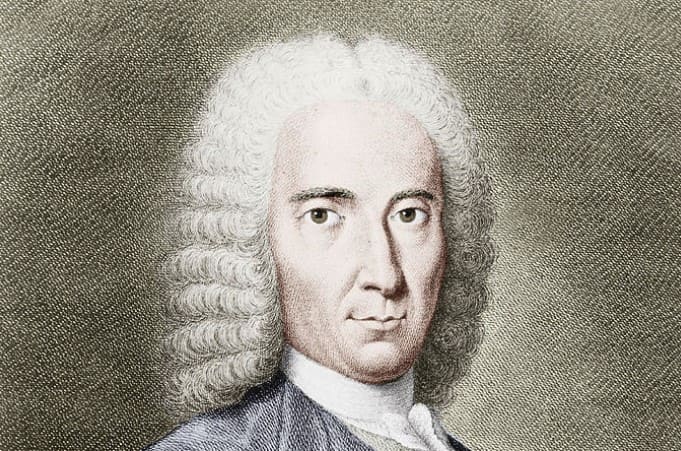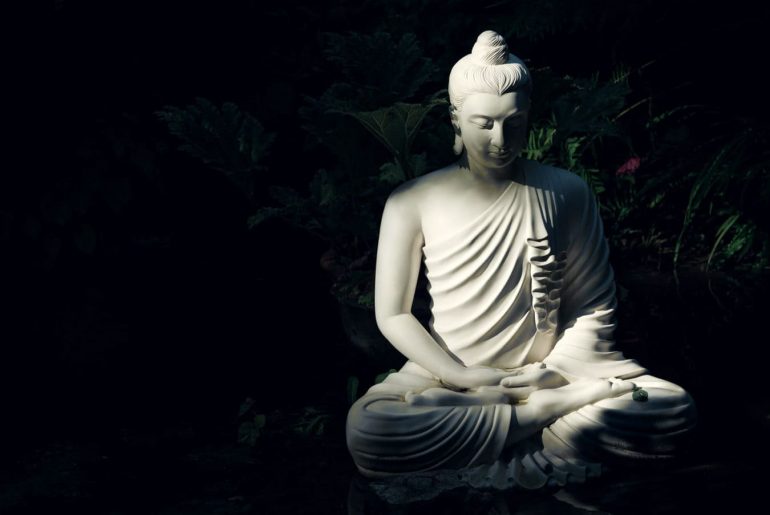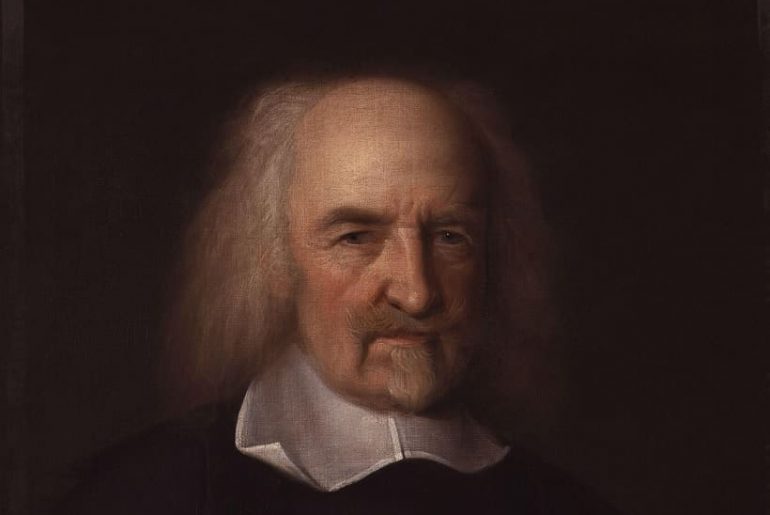SIMONE DE BEAUVOIR, JEAN-PAUL SARTRE’s partner, is described as a pioneer of feminism. She fought back, saying, “I never thought of myself as a ‘woman’, I was me.”
She is also considered by some to be the actual creator of existentialism. The catchphrase of existentialism comes from her: “Man is born free.”
What part it has in SARTRE’s existential philosophy can hardly be determined.
Her major literary themes were freedom, human rights and emancipation.
SIMONE DE BEAUVOIR is described as a pioneer of feminism.
Her most famous sentence is:
“On ne naît pas femme: on le devient”
“One is not born a woman, one becomes one.”
(Beauvoir, Simone de: The other sex custom and sex of the woman. Reinbek near Hamburg: Rowohlt, 1949)
Creator of existentialism
DE BEAUVOIR is considered by some to be the actual inventor, the creator of existentialism. The catchphrase of existentialism comes from her: “Man is born free.”
She saw her partner JEAN-PAUL SARTRE as her teacher and herself only as “the second”. What part it has in SARTRE’s existential philosophy can hardly be determined. Her major literary and philosophical themes were
- Freedom,
- human rights,
- Emancipation,
- self-determination and
- Equal rights.
DE BEAUVOIR is about questions of human existence in general. Each person must choose their own path. Individuals are defined by their actions, not by religion, ideology or doctrine. He must act according to his own convictions and personal experience: According to SARTRE, we must “create our essence through our actions”. How he wants to live is the individual decision of the individual himself. Man determines his destiny, he has the choice. Even if man refuses to make a choice, i.e. to determine his life path, he chooses. According to SARTRE, he is “damned to freedom”, but he also takes on responsibility for shaping his freedom. In her works, DE BEAUVOIR primarily shed light on the role of women and their responsibility for shaping their existence. So her motto in life can be understood as the “parole” of existentialism, because she not only conceived existentialism, but also lived it:
“My most important work is my life”.
Childhood and adolescence
SIMONE LUCIE ERNESTINE MARIE BERTRAND DE BEAUVOIR was born in Paris on January 9, 1908 as the firstborn “fille rangée”, the “superior daughter” of the lawyer GEORGES DE BEAUVOIR and his wife, the librarian FRANÇOISE DE BEAUVOIR, née BRASSEUR. The sister POUPETTE was two and a half years younger. The siblings grew up in their parents’ upper-class apartment on Boulevard Montparnasse.
The mother was a devout Catholic, the father an agnostic. This contrast also initially determined SIMONE’s ideas about later life: she wanted to go into a monastery. At the age of four she taught herself to read and increasingly discovered the world of poetry. In this she agreed with her father, whom the girl greatly admired, above all because of his erudition.
In 1913, SIMONE started school at the Cours Adeline Désir, a Catholic institute for girls. She was a spirited and inquisitive child: “I got off to a good start,” she later wrote of her childhood. The First World War drastically changed the parents’ economic circumstances: In 1919, the family had to move to 71 Rue de Rennes for financial reasons. It was here that the memorable incident took place which – according to her own statements – shaped the life of BEAUVOIR. Her father casually remarked: “How ugly you are!” and preferred to show himself in public with the much more beautiful POUPETTE. From now on, the pubescent girl buried herself in her books. In 1925, SIMONE graduated from school with a baccalauréat. In 1925 she began studying philology at the Institut Sainte-Marie in Neuilly and mathematics at the Institut Catholique in Paris. She studied philosophy at the Sorbonne in 1926/27 and wrote her diploma thesis on the philosopher and polymath GOTTFRIED WILHELM LEIBNIZ (1646–1716) in 1928/29. Her wish was to become a teacher.
JEAN-PAUL SARTRE and DE BEAUVOIR
Therefore, DE BEAUVOIR prepared to teach (agrégation) at the Ecole Normale Supérieure (ENS), where she met JEAN-PAUL SARTRE in July 1929. Behind him she passed the agrégation as the second best. The relationship between the two began in that year, but SIMONE DE BEAUVOIR and SARTRE used to use one another’s sies throughout their lives:
He called her “Petit charming Castor” (their correspondence appeared in: “Lettres au Castor et á quelques autres”).
The dualism “like Castor and Pollux” is commonly used for a close male friendship. Castor means beaver in German, but could also stand for the inseparable pair of twins Castor and Pollux (French: Castor et Pollux), which was popularly believed by seafarers to be the savior in need. But Castor is also that fixed star in the sky that is part of the constellation of Gemini: According to the Greek legend, Castor and Polydeukes (i.e. Pollux) lived inseparably after Castor’s death in the Trojan War, alternately in Hades and Olympus, until Zeus as stars in the sky. The picture of Castor and Pollux therefore aptly symbolizes the almost symbiotic relationship between SARTRE and DE BEAUVOIR.
Both had other side relationships during their lives, some very enduring, but none could destroy the love SARTRE and DE BEAUVOIR had for each other.
They never shared a common apartment so that each could keep their independence. They were truly equals to each other, both in thought and in acting out their sexuality. DE BEAUVOIR rejected the marriage offered to her by SARTRE as “restrictive bourgeoisization and institutionalized interference by the state in private affairs”. Both tried a relationship with five as a heterosexual and homosexual partnership at the same time: SARTRE, DE BEAUVOIR, two young women and a young man.
Teacher and writer
After getting her teaching license, DE BEAUVOIR initially taught as a private tutor in Paris in order to be close to SARTRE.
After SARTRE went to Le Havre, she taught at various lyceums in Marseille, Rouen and Paris until 1943.
DE BEAUVOIR spent the time of the German occupation of France during the Second World War from 1940 to 1944 in Paris. She also studied here
ALBERT CAMUS (1913-1960),
JEAN GENET (1910-1986),
ALBERTO GIACOMETTI (1901-1966) and
PABLO PICASSO (1881-1973)
know. They often met at Café Flore on Boulevard St. Germain-des-Prés. In 1943, when she defended a schoolgirl’s relationship with a Jewish boy, she was fired. From then on, DE BEAUVOIR worked as a freelance writer. In her novel “Le sang des autres” (Eng.: “The Blood of Others”, 1945), DE BEAUVOIR dealt with the time of the occupation. In 1943 her first novel “L’Invitée” (Eng.: “She came and stayed”) was published, a love triangle in which she addressed SARTRE’s relationship with her and another woman.
After the war
After the war, DE BEAUVOIR collaborated on the political-literary magazine Les Temps Modernes, founded by SARTRE. Some of her most important essays also appeared here.
“All men are mortal”
The novel “Tous les Hommes sont mortels” (Eng.: “All men are mortal”), published in 1946, takes up a subject that had already been discussed by other authors before her: that of the protagonist wandering through time as an immortal. In “Orlando: A Biography” (1928), VIRGINIA WOOLF (1882–1941) created a main character who, in search of identity, acted at different times as a man and at other times as a woman. This topic of gender-specific role expectations became the central reason for DE BEAUVOIR’s writing.
In All Men Are Mortal, set in France in the 1940s, the young actress Regine meets the strange and, as she later realizes, immortal Raymond Fosca, who was born in 1279 in the town of Carmona, Italy, and who, seeks a means of eternal life in order to serve his city forever. The hero roams through European history for six centuries to realize that he can do nothing, that people’s longings and hopes are in vain.
“All Men Are Mortal” is a novel in which DE BEAUVOIR deals with questions of existential philosophy. This will include clearly in the figure of Armand.
Transience can also be an opportunity, even if the life of the individual does not leave the “very faintest trace”.
“The Other Sex”
In this novel, the important, moving questions of human existence are still put into the mouths of men. As early as 1949, DE BEUVOIR sat down in her book “Le Deuxiéme Sexe” (Eng. 1951: “The Other Sex”) with “customs and sex of women ‘ (subtitles) apart. This book, a draft of an existentialist ethic, addresses the role of women in society and caused such a stir that it was condemned by the Vatican for “immoral doctrines that trample on morality and the sanctity of the family” (In: ” L’Osservatore Romano”) was placed on the Index of Prohibited Books.
“The Second Sex”, a classic of the women’s movement, analyzes and criticizes the prevailing patriarchal worldview of the time. The man, “the subject, .. the absolute” is opposed to the woman as “the other”.
SIMONE DE BEAUVOIR ends “The Second Sex” with a quote from KARL MARX:
“The immediate, natural, necessary relationship of man to man is the relationship of man to woman. It follows from the character of this relationship to what extent man as a species, as man, has become and grasped himself; the relation of man to woman is the most natural relation of man to man. It thus shows to what extent man’s natural behavior has become human and to what extent his human nature has become his nature.”
(Karl Marx: Economic-philosophical manuscripts, In: Karl Marx, Friedrich Engels: Works. Berlin 1968, Volume 40, p. 535)
“The Mandarins of Paris”
The novel The Mandarins of Paris, considered a key work of the existentialist movement, is set in post-World War II France. Now the main female character, the psychologist Anne, describes her search for personal happiness. The journalist Henri, on the other hand, symbolizes the inner turmoil and disintegration of French intellectuals after the end of the war and after the Resistance. The novel is based in part on the author’s relationship with SARTRE and American NELSON ALGREN (since 1947).
In 1955, SIMONE DE BEAUVOIR received the Prix Goncourt, the most prestigious literary award in France, for her novel Les Mandarins. At that time, DE BEAUVOIR was in a relationship with CLAUDE LANZMANN, with whom she also lived.
In 1955, DE BEAUVOIR traveled to China and the Soviet Union with SARTRE. This resulted in “La longue marche” (“China – the far-reaching goal”, 1957). She visited the Soviet Union several times between 1962 and 1966 to campaign for the release of imprisoned government critics.
SARTRE and DE BEAUVOIR turned against the effects of the Cold War raging in Europe and took part in the 1955 Helsinki Peace Conference.
Since 1958 her three-part autobiography “Mémoires dúne jeune fille rangée” (Eng: “Memoirs of a daughter from a good family”) has been published.
In 1963 his mother died of cancer. In “Une Mort très douce” (Eng.: “A Gentle Death”, 1964) she described their suffering.
The “conscience of France, Europe, yes the West”, SIMONE DE BEAUVOIR, and SARTRE attended the Russell tribunal in Copenhagen in 1967 to discuss American war crimes during the Vietnam War and denounced US interference as military aggression and the bombing of civilian targets the Americans as genocide. In 1968 they supported the rebellious students during the May riots in Paris.
President of the League for Women’s Rights
In 1974, DE BEAUVOIR became President of the “League for Women’s Rights” in France.
SARTRE, who smoked heavily in his life and drank copious amounts of Scotch and red wine, suffered from pulmonary edema, cirrhosis of the liver and circulatory disorders in the brain. He died on April 15, 1980. In “La Cérémonie des adieux, suivi de Entretiens avec Jean-Paul Sartre (août-septembre 1974)” (Eng.: “The Farewell Ceremony and Conversations with Jean-Paul Sartre”), DE BEAUVOIR 1981 the last years of life and the infirmity of the partner. She reported openly and relentlessly, so that she aroused indignation and horror. She noted that these so-called “friends” had not grasped the principle of existentialism.
At that time, she herself was already marked by age and alcohol consumption, and walking was becoming increasingly difficult for her, as MARGARET A. SIMONS reports.
SIMONE DE BEAUVOIR died in Paris on April 14, 1986.
She was buried next to JEAN-PAUL SARTRE in Montparnasse Cemetery in Paris.
Works
“L’Invitée” (“She came and stayed”), 1943
“Le sang des autres” (“The Blood of Others”), 1945
“Les bouches inutiles”, play, 1945
“Tous les hommes sont mortels” (“All men are mortal”), 1946
“Pour une morale de l’ambiguité” (“For a Morality of Ambiguity”) article, 1947
“L’Amérique au jour le jour (“America – by day and night”), 1948
“Le deuxième sexe” (“The Second Sex”), 1949
“Les mandarins” (“The Mandarins of Paris”), 1954
“La longue marche” (“China – the far-reaching goal”), 1957
“Mémoires d’un jeune fille rangée” (“Memoirs of a daughter from a good family”), with:
– “La Force de l’âge”, 1960, dt.: “In the best years”,
– “La Force des choses”, 1963, German: “The course of things” and
– “Tout compte fait”, 1972, German: “All in all”
“La Force de l’âge” (“In the prime of life”), 1961
“La Force des choses” (“The Way Things Go”), 1963
“Une Mort trés douce” (“A Gentle Death”), 1964
“Les Belles Images” (“The World of Beautiful Pictures”), 1966
“La Femme rompue” (“A Broken Woman”), 1967
“La Vieillesse” (“Old Age”), 1970
“Tous compte fait” (“All in all”), 197
“La cérémonie des adieux” (“The Farewell Ceremony”), 1981
“Journal de guerre, Septembre 1939 – Janvier 1941” (ed. by Sylvie le Bon de Beauvoir), 1990
What did Simone de Beauvoir do?
Simone de Beauvoir is a French writer and philosopher. She is one of the founders of the philosophy of existentialism and is a close confidant of Jean-Paul Sartre.
When did Simon de Beauvoir die?
April 14, 1986
How old was Simone de Beauvoir?
78 years
Where did Simone de Beauvoir die?
Paris, France
How do you pronounce Beauvoir?
Simone Lucie Ernestine Marie Bertrand de Beauvoir [siˈmɔn də boˈvwaʁ] (9 January 1908 in Paris – 14 April 1986 in Paris) was a French writer, philosopher and feminist.
Does Simone de Beauvoir have children?
Sylvie Le Bon de Beauvoir is a French writer and philosophy professor. She is the adopted daughter of Simone de Beauvoir. The meeting of the two women was described in the book All in All that Simone de Beauvoir dedicated to her.
Where is Simone de Beauvoir buried?
The Cimetière du Montparnasse is one of the three large Parisian cemeteries that were laid out at the beginning of the 19th century and thus before the last incorporation outside the then city limits. The Montmartre Cemetery and the famous Père Lachaise Cemetery as well as the Passy Cemetery were also created at that time.
When was Simone de Beauvoir born?
January 9, 1908
Where was Simone de Beauvoir born?
6th arrondissement of Paris


